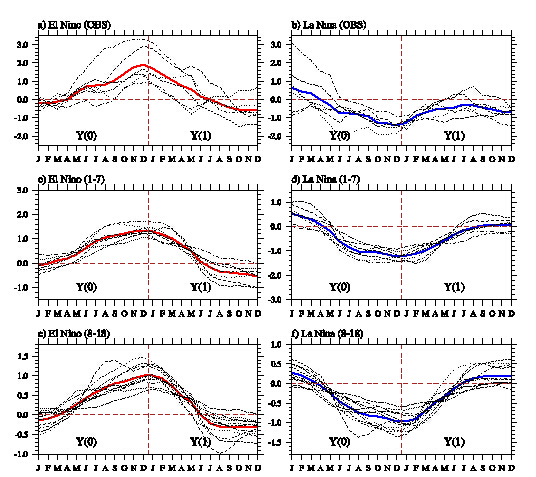ENSO is the strongest external forcing on the interannual variability of the East Asian-western North Pacific (EA-WNP) monsoon. During past 20 years, the relationships between ENSO and EA-WNP monsoon were widely studied. At present, it is accepted that the anomalous anticyclone/cyclone over the tropical western North Pacific (WNPAC/WNPC) are the key bridges linking the ENSO and the EA-WNP monsoon. However, most studies focused on how ENSO influences the EA-WNP monsoon, while less attention was paid on how the monsoon modulates ENSO.
Recently, Drs. Bo Wu and Tianjun Zhou from the Institute of Atmospheric Physics investigated the mechanisms responsible for the evolution and maintenance of the WNPAC/WNPC, and their impacts on the ENSO based on the CMIP5 multi-model ensemble. It was found that during ENSO mature winter, El Nino-related WNPAC is significantly asymmetric with the La Nina-related WNPC. The asymmetric atmospheric circulation anomalies play important roles in the asymmetric decaying rate of ENSO. The asymmetric decaying rate of ENSO means that El Nino tends to decay much faster La Nina. El Nino tends to evolve to a neutral state during the summer after the mature winter, while La Nina tends to persist to the next winter (Fig. 1a, b).

Fig. 1. Temporal evolutions of monthly mean Niño3 SST anomalies. The six thin black lines in (a) represent the individual El Niño events in the observation, respectively. The thick red line represents the composite of the six El Niño events. (b) As in (a) except for La Niña. Comparing (a) with (b), it is clear that El Nino tends to decay faster than La Nina. The seven thin black lines in (c) represent the El Niño composites simulated by models 1–7, respectively. All these seven models can simulate the asymmetry between WNPAC and WNPC. The thick red line represents the simple ensemble mean of the seven thin lines. (d) As in (c) except for La Niña. (e, f) As in (c, d) except for models 8–18. All these nine models cannot simulate the asymmetry between WNPAC and WNPC. (Wu and Zhou, 2015)
They also concluded that those models that can (cannot) simulate the asymmetry between the WNPAC and WNPC tend to reproduce ENSO with asymmetric (symmetric) decaying rates (Fig. 1c-f). On the other hand, results of the multi-model ensemble indicates that in El Niño decaying summers, the WNPAC is maintained due to the sequential effects of the local forcing of the underlying cold SST anomalies and the remote forcing from the basin wide warming in the tropical Indian Ocean.
Citation: Wu, B. and T. Zhou, 2015, Relationships between ENSO and the East Asian–western North Pacific monsoon: observations versus 18 CMIP5 models, Climate Dynamics, In press. DOI 10.1007/s00382-015-2609-y
Download: http://link.springer.com/article/10.1007/s00382-015-2609-y
Contact: Dr. WU Bo, wubo@mail.iap.ac.cn






